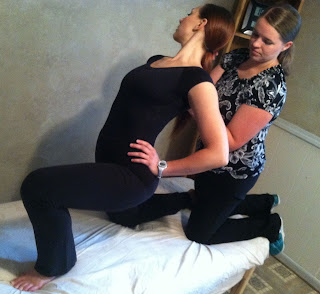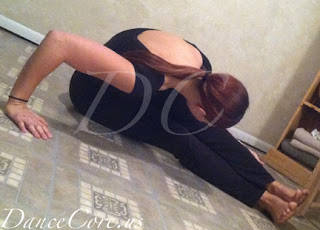The 1 2 3 of How to stretch and prevent injury (instructions)
Do you remember elementary school when your gym teacher told you to reach for your toes and try to touch them? I do. What I don't remember is any instruction on what it should feel like and what creates injury. In fact I didn't have an instructor teach me how to stretch until I had been at Brigham Young University for six years.
When you've been athletic for eleven years without correct stretching technique you're bound to end up with a lot of injuries.
Rules:
#1 Stretch until you just barely feel it. Really.
(Until I started teaching I didn't truly believe this. I would demonstrate stretches without "feeling" it to demonstrate and I quickly discovered that I was increasing my flexibility.)
#2 The first stretch is 30 seconds.
(When you first go into the stretch you should hold back and let your muscle spindle cells trust you and release. Plus you are heating up the fascia so that it will allow the muscle to stretch without tearing.)
#3 The second stretch is 10 seconds.
(After the muscle spindle cells and fascia release you go deeper into the stretch. It is a gentle feeling. If you cannot go deeper you did stretch #2 too hard.)
Kristy Lynne's hard knocks
Ronald Nuttal, BYU Dance Athletic Trainer, completely got rid of my tendonitis. He had brian use his knuckles and press out the knots in my supinators and my intrinsics. For an hour each night Brian would scour my lower leg and feet for any knot and press out the knots. I cried. Then he would spend another hour using ice cubes until my leg was completely cooled down.
An easier way? Stretching. I tell you, it feels a lot better. Inflamation, tight fascia, and static contractions are the culprit. So, I stretch all the way around my foot. I have discovered how to stretch the hallicus flexor and learned how to massage out trigger points. It has been lovely alleviate and prevent the knots.
An easier way? Stretching. I tell you, it feels a lot better. Inflamation, tight fascia, and static contractions are the culprit. So, I stretch all the way around my foot. I have discovered how to stretch the hallicus flexor and learned how to massage out trigger points. It has been lovely alleviate and prevent the knots.
Knee pain:
ABOVE THE KNEE - most usually means that your quadreceps are tight. They connect in front of your hip and go over the top of the kneecap and attach onto the Tibia.
Get down on one "bended knee" as if proposing. With your body upright bend the front knee and feel the stretch on the knee that is on the floor. You will feel the stretch on the front of your quad that is pointed to the floor or in your hip. (This particular client is a professional dancer and needed support to go further into the stretch by arching her back to access the Psoas more).
I suggest putting something soft under your knee until your quads are more loose. Any floor will feel hard until your quads consistently release their tension.
(If you don't feel the stretch tilt your pelvis to the "ceiling" or as far as it will go.)
OUTSIDE OR BELOW THE KNEE - most usually means that your Ilio-Tibial Tract is tight. Otherwise called your IT Band. This band connects on the gluteus medius and the tensor fascia latae muscles in front, to the side and behind your hip bones, gathers and runs down the side of your thigh. when it reaches your knee it attaches itself in several places starting with the outside of your knee and going around to the inside on the bottom.
Sit on the floor with STRAIGHT legs. Roll up on your side staying up on the side of your leg and hold your body up as if you were a mermaid (if you need to do this against a wall so that you can be straight make sure your legs, glutes and back are touching the wall).
Remember 30 + 10 for each individual stretch.








